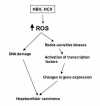Reactive oxygen species: role in the development of cancer and various chronic conditions
- PMID: 16689993
- PMCID: PMC1479806
- DOI: 10.1186/1477-3163-5-14
Reactive oxygen species: role in the development of cancer and various chronic conditions
Abstract
Oxygen derived species such as superoxide radical, hydrogen peroxide, singlet oxygen and hydroxyl radical are well known to be cytotoxic and have been implicated in the etiology of a wide array of human diseases, including cancer. Various carcinogens may also partly exert their effect by generating reactive oxygen species (ROS) during their metabolism. Oxidative damage to cellular DNA can lead to mutations and may, therefore, play an important role in the initiation and progression of multistage carcinogenesis. The changes in DNA such as base modification, rearrangement of DNA sequence, miscoding of DNA lesion, gene duplication and the activation of oncogenes may be involved in the initiation of various cancers. Elevated levels of ROS and down regulation of ROS scavengers and antioxidant enzymes are associated with various human diseases including various cancers. ROS are also implicated in diabetes and neurodegenerative diseases. ROS influences central cellular processes such as proliferation a, apoptosis, senescence which are implicated in the development of cancer. Understanding the role of ROS as key mediators in signaling cascades may provide various opportunities for pharmacological intervention.
Figures



References
-
- Weinberg RA. How cancer arises. Sci Am. 1996;275:62–70. - PubMed
-
- Sugimura T. Cancer prevention: past, present, future. Mutat Res. 1998;402:7–14. - PubMed
-
- Halliwell B. Oxygen and nitrogen are pro-carcinogens. Damage to DNA by reactive oxygen, chlorine and nitrogen species: measurement, mechanism and the effects of nutrition. Mutat Res. 1999;443:37–52. - PubMed
-
- Scandalios JG. The rise of ROS. TIBS. 2002;27:483–486. - PubMed
LinkOut - more resources
Full Text Sources
Other Literature Sources

